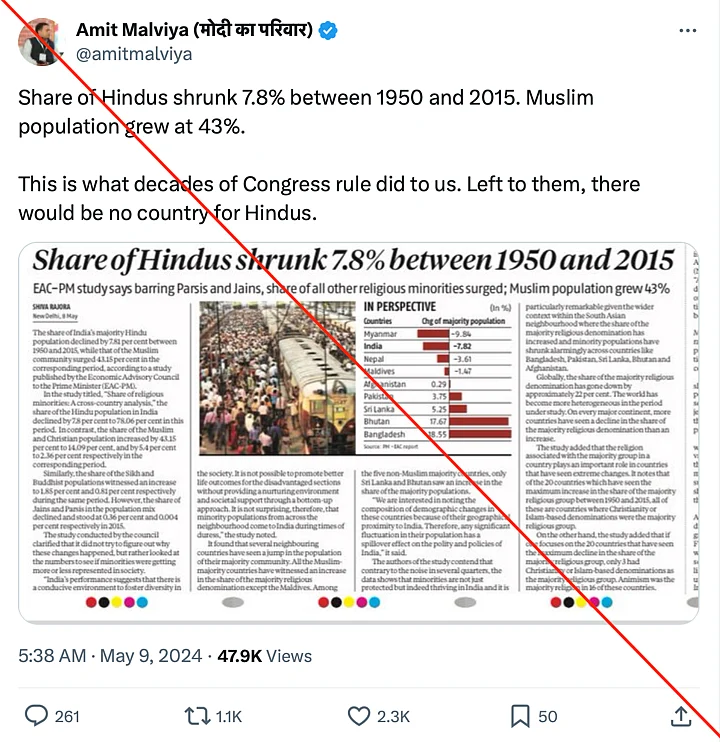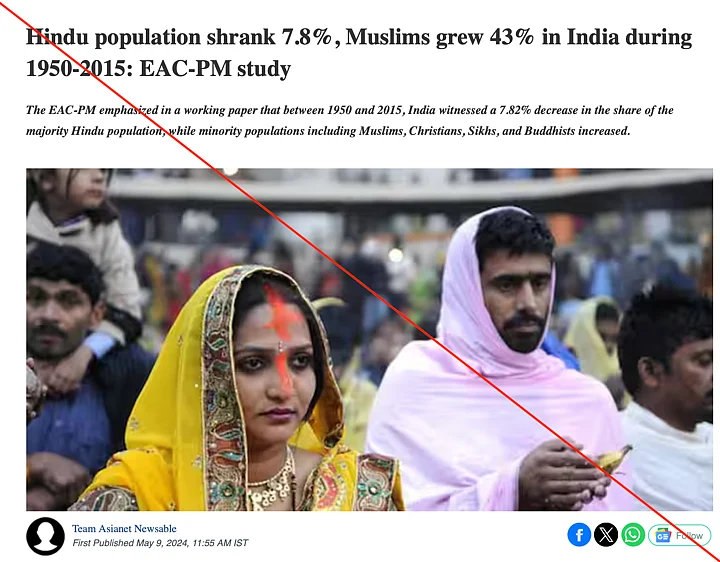After the Prime Minister's Economic Advisory Committee released a cross-country report about religious minorities in May, several news organisations and social media users shared some of the report's findings.
The claim: News organisations and social media users have published some findings from the report, claiming that the percentage of Hindus in India fell by around eight percent, while the percentage of Muslims rose by approximately 43 percent.
Who shared this?: Bharatiya Janata Party's (BJP) IT Cell head Amit Malviya, news organisations Asianet, Business Today, Financial Express, News9 and right-wing website OpIndia shared the claim.
(Swipe to view screenshots of some claims.)
But...?: The viral claim is misleading.
We looked at the report and found that while the percentage of Hindus fell by 7.82 percentage points, the percentage of Muslims rose by 4.25 percentage points.
Moreover, the social media posts do not include the increase in absolute numbers.
Looking at 167 countries in its analysis, the paper mentioned that globally, the share of majority religious denomination had gone down by 22 percent over the specified period of 65 years.
Focusing on India, the report stated that India saw "a reduction in the share of the majority religious denomination by 7.81 percent."
Adding on to this, the paper said that this was "particularly remarkable" because India's neighbours – Bangladesh, Pakistan, Sri Lanka, Bhutan, and Afghanistan – saw a decline in minority populations.
According to the report, this indicated that "minority populations from across the neighborhood come to India during times of duress (sic)."
Apart from India, the other non-Muslim majority countries where a decline in the share of the majority religious was observed were Myanmar and Nepal.
The paper also included the mathematical formula it used to determine the rate of change of a population between 1950 and 2015.
What about the viral figures?: A section of the report explored the changing religious demographics in the south Asian region, including SAARC (South Asian Association for Regional Cooperation) countries – Afghanistan, Bangladesh, Bhutan, India, Maldives, Nepal, Pakistan, and Sri Lanka – and Myanmar.
Under the subheader for India it mentioned that the share of India's majority (Hindu) population decreased by 7.82 percent over 65 years – from 84.68 percent of India's population in 1950 to 78.06 percent in 2015.
By subtracting the percentage for 2015 from that of 1950, we get -6.62 percent, showing that the Hindu population fell by 6.62 percentage points.
Calculating the rate of change of Hindus in India in this time period using the formula mentioned in the paper, we saw that that rate of decline was 7.82 percent.
Similarly, the paper mentioned that in 1950, Muslims made up 9.84 percent of India's population, which increased to 14.09 percent in 2015.
This shows that the number of Muslims increased by 4.25 percentage points in 65 years.
Next, we calculated the rate of change of the Muslim community in India using the same formula, which showed that the number of Muslims in India had grown by 43.19 percent.
What does census data say?: We looked at available official census data for this time period.
To establish the number of people from the Hindu and Muslim communities during this period, we looked at census reports from 1951 and 2011.
Since the 1951 census reports did not carry data about population by religion, we referred to this table showing percentage shares of different religions, which was published in the 2018 Handbook of Social Welfare Statistics, by the Ministry of Social Justice and Empowerment.
These reports and charts showed us that in 1951, India had a population of 36 crore people, of which 84.1 percent belonged to the Hindu community and 9.8 percent were from the Muslim community.
In numbers, India had approximately 30.2 crore Hindus and 3.53 crore Muslims in 1951.
Similarly, in 2011, India had 96.63 crore Hindus, who made 79.8 percent of our total population, and 17.22 crore Muslims, who were 14.2 percent of all Indians.
On comparing these numbers, it becomes evident that the overall number of Hindus has increased by 66.43 crore, and has not gone down, as some versions of the claim may imply.
Between 1951 and 2011, the population share of Hindus in India has gone down by 4.3 percent, whereas the share of Muslims has gone up by 4.4 percent.
Here, it can be seen that since the total number of Muslims in 1951 was quite low (3.53 crore), the rate of change in population share looks high in the latest census data, which mentions 17.22 crore Muslims in 2011.
Experts call out media misinformation: The Population Foundation of India, a non-profit which works towards better formulation and implementation of policies, issued a statement calling out the misleading narratives.
In its statement, the body said it was "deeply concerned" about the misrepresented findings which were "not only inaccurate but also misleading and baseless."
"The media's selective portrayal of data to highlight the increase in the Muslim population is an example of misrepresentation that ignores broader demographic trends," said Poonam Muttreja, Executive Director, Population Foundation of India, according to the statement.
It touched upon the decadal growth rate for Muslims, which "has been declining over the past three decades," and is more pronounced than that of Hindus, drawing parallels with census data for the same period, which show similar trends.
The narratives in some claims furthered the popular debunked claim that there is a population imbalance in India with respect to Hindus and Muslims. The claim has been debunked by Team WebQoof too.
Conclusion: The viral headline and claim compares two different figures to make a misleading claim about the change in Hindu and Muslim population in India.
(Not convinced of a post or information you came across online and want it verified? Send us the details on WhatsApp at 9540511818 , or e-mail it to us at webqoof@thequint.com and we'll fact-check it for you. You can also read all our fact-checked stories here.)
(At The Quint, we question everything. Play an active role in shaping our journalism by becoming a member today.)


